Brew Your Own Kombucha – Which Brew is Right for You?
This post may contain affiliate links. Read my full disclosure here.
Kombucha sells for $3 – $4 (or more) commercially, but you can brew your own kombucha for just $1 -$2 per gallon. It’s great for your digestion, and has helped more than one person kick the soda habit. It is carbonated, can be lightly sweetened if desired and lends itself to a variety of flavors. In this post I’ll explain what kombucha is, how it tastes and how to make it. We’ll also compare regular brewing versus continuous brewing.
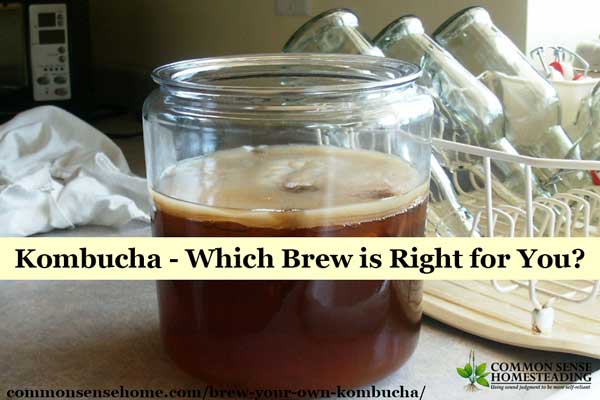
What is Kombucha?
Just in case you’ve read this far but have no idea what I’m talking about. 🙂 Kombucha is a probiotic beverage made from sweetened tea. The culture using for brewing the kombucha is commonly referred to as a SCOBY, (Symbiotic Colony of Bacteria and Yeast). The kombucha culture is also known as a mushroom, mother, starter and various other names. The basic brew has been around a long time and been enjoyed by many people. As you can see in the photo below, the SCOBY is a weird, mushroom/pancake looking thing. A new scoby normally forms at the top of the container each time you brew. If you have a healthy culture and brew regularly, you will have baby scobys to share.
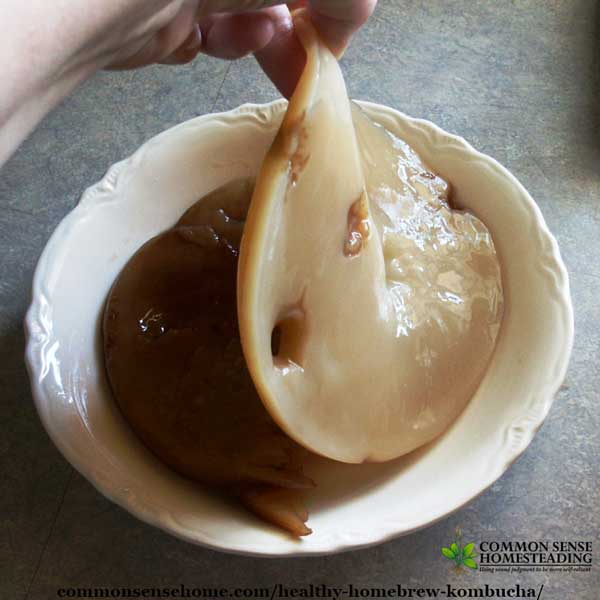
What Does Kombucha Taste Like?
Kombucha is always somewhat acidic (that’s one of the ways that you know it’s brewing – the tea changes from sweet to tart). The final flavor varies greatly with the age of the brew, the tea you start with, and whether or not you add additional flavorings. Leave your brew too long and it’ll taste more like vinegar.
I like to use loose leaf organic tea. The flavor is better, you know you’re getting good quality and you’re not paying for extra packaging. I keep one batch of Orange Pekoe (which is a black tea) and one batch of almond blossom oolong tea going all the time now. Black tea kombucha has a stronger flavor and is the traditional choice for brewing kombucha. The oolong is more mellow and fruity without adding any fruit juice for flavoring. I often drink the almond Blossom Oolong “as is”, without additional flavorings, and add my flavors only to the black tea brew. Over the years I’ve come up with flavor blends from Pumpkin Spice to Pina Colada – the only limit is your imagination. Just don’t brew your kombucha with flavored teas that contain oils, like Earl Grey. These can kill your SCOBY over time.

Can Kombucha Bottles Explode (Like Wine Bottles)?
While I have never had shattered glass, I have fired the contents of a bottle of kombucha from the kitchen to well across the dining room. I am pretty sure there are still some chunks of raspberries in one of the under cabinet light fixtures. In warm condition, carbonation can build up very quickly. Make sure to burp your bottles to let off excess gas, or keep them chilled to slow down gas production. Otherwise you may end up like the gentleman below, or worse.
What Do I Need to Brew Kombucha?
All you need is a starter culture, some tea, some sugar (the culture eats the sugar), clean water (no chlorine!), a container (preferably glass) and something to cover the opening of the container (I use a flour sack towel and rubber band). In about 7-10 days, you’ll have kombucha.
With regular brewing, you set aside the scoby and some of your current batch to act as a starter for the next batch. If you use continuous brewing, you draw finished brew off the bottom and add fresh tea to the top.
The post How to Make Kombucha includes step by step instructions for brewing kombucha at home.
You can purchase a starter through Kombucha Kamp, as well as the rest of the supplies you need for brewing or continuous brewing. (Your Kombucha Kamp purchase helps support this site at no extra cost to you.) You can also google “buy kombucha SCOBY” or “free kombucha SCOBY” and your area to look for local places to buy or possibly get one for free in your area.
Would you like to save this?
Where Should I Brew Kombucha?
I keep mine in a corner of my kitchen, at least five feet away from other live cultures. You want a spot that is between 70 and 80 degrees F where the culture will not be disturbed. Colder temps will lead to slower brewing. Some folks keep the brew on top of the fridge for extra warmth. My brother kept his on top of his TV. Do keep your kombucha out of direct light. Indirect light or darkness is fine. Some air flow is a good idea. (Don’t put it in a jar with a tight lid.)

Is Kombucha an Alcoholic Beverage?
There is a very small amount of alcohol in kombucha – that’s what yeast does to sugar. It should be less then 0.5%. If you add a lot of fruit juice and put it somewhere warm, you can probably drive this number up, but I’ve never had any batch get close to what I would consider “winey”. This is “booch”, not “hooch”.
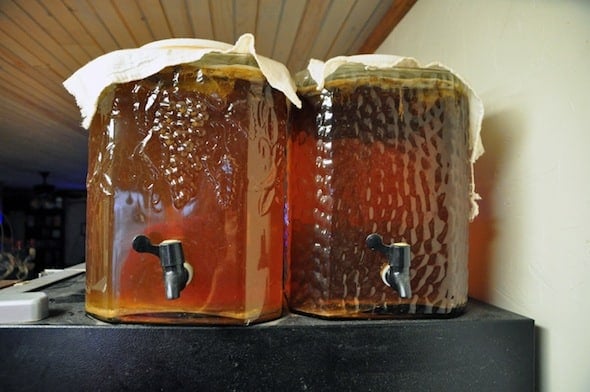
Continuous Brew Kombucha
In a kombucha continuous brewing system, finished kombucha is drawn off and new tea is added to the existing brew. It can cost a little more up front, because you’ll want to invest in a fermentation vessel with a spigot to draw off the finished kombucha.
Some advantages of this brewing system include:
- Less maintenance. The brewing container only needs to be cleaned once in a while, instead of with every batch.
- Better odds of successful brewing. Less handling of the scoby and containers means lower risks for introducing stray microbes.
- Minimal SCOBY disturbance. Just like avoiding tilling protects soil life, keeping the scoby fed and happy let’s the beneficial microbes thrive.
- Continuous brewing provides short and long brew kombucha benefits in one container. Shorter fermentation time yields kombucha with a milder flavor, but longer fermentation yields more probiotics. Continuous fermenting maintains a mellow flavor AND more probiotics.
Examples of continuous brewing setups include:
Continuous Kombucha from Real Food Forager – Dina-Marie has a larger volume system to keep her large family in a steady supply of kombucha. She maintains two 4.75 gallon glass dispensers, which she drains into a keg for easy access for the kids. (Pictured above.)
Kombucha Continuous Brewing System @ Pickle Me Too – Melanie’s system keeps about one gallon of kombucha going at all times, drawing of a quart at a time as needed. She keeps a gallon of sweetened tea in the fridge to add to the brew as she draws off the finished kombucha. (Pictured below.)

Brew Your Own Kombucha Info Roundup
- Water Kefir Versus Kombucha – What’s the difference between water kefir and kombucha? Both are probiotic beverages you can brew at home, but which one is best for you?
- Kombucha Q and A and More Flavoring Ideas – More flavoring ideas and all the Q and A from the comments in a more readable format
- Holiday Kombucha Flavors for Unique Seasonal Drinks
- How to Make Coffee Kombucha – use extra SCOBYs to transform coffee into a probiotic beverage. Great for making iced coffee (don’t heat it up, or you’ll kill the beneficial bacteria).
- The SCOBY Cure – Home Remedy for Cradle Cap – how I used a kombucha SCOBY to cure my son’s cradle cap.
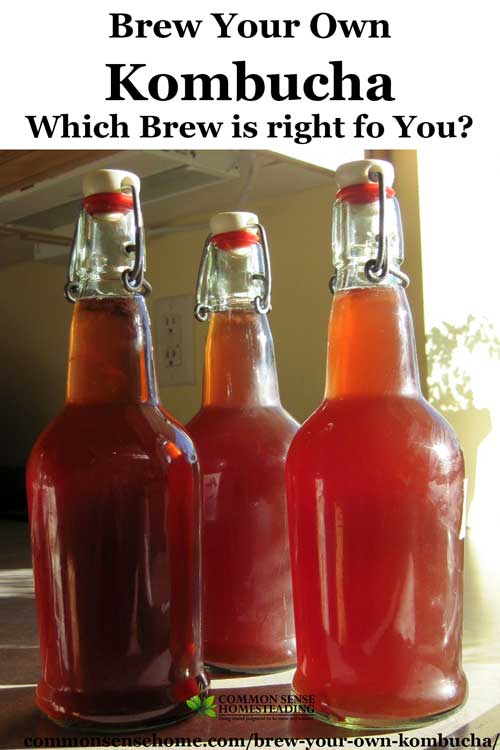
Originally published in 2013, updated in 2017.

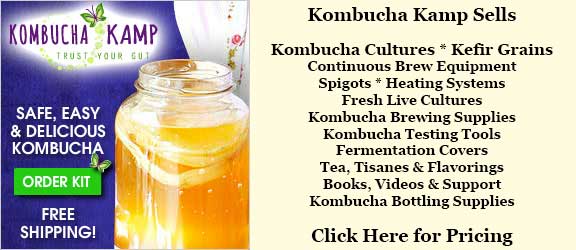
Hi, and thanks for all the good info. I am a diabetic so I count carbs and would like to know if kombucha would be a a drink I could live with
The article “Kombucha and Diabetes” states:
“Kombucha tea is said to have a number of effects that make it of interest to diabetics. For example, if you use a more sour tea, kombucha may help by moderating fluctuations in blood sugar. In addition, it reportedly helps with diabetic complications such as high blood pressure and improving your cholesterol profile. It’s also said to increase energy and improve digestion. Unfortunately, little modern scientific evidence exists to support any of these claims. The NYU Langone Medical Center reports the earliest investigations of kombucha took place in Germany in the 1930s, but more recent studies have been examining kombucha as a probiotic. For example, a January-March 2011 article in the “Journal of Indian Society of Periodontology” studied the promise of kombucha and other healthful bacteria in fighting periodontal disease, of which diabetics are at greater risk than nondiabetics. Scientists also suspect that changes in the bacteria in the gut can affect the uptake of carbohydrates and thus, blood sugar control.”
Always check with your doctor to make sure supplements won’t interact with any medication that you may be on of condition that you may have, and start slowly when adding kombucha to your diet.
Hi! I have gerd and I was able to try kombucha in the U.S I’m from the Philippines and I would like to know if there’s a way I can brew my own. Our country is very warm. Thank you!
If you can find a scoby, you should be able to brew, it will just be ready to drink very quickly. I’m not sure what regulations apply, if any, for shipping live cultures to the Philippines, and how they would safely be handled during transport to keep them alive in the heat. I’ve heard of people traveling abroad carrying a strip of scoby in a water bottle with sweet tea to feed it.
A good suggestion to prevent a hazardous situation and minimize mess in the case of an exploding bottle is to place your bottled brew into a room temperature cooler until it’s ready to go into the fridge.
I have blown the bottom of out a couple of Grolsch bottles of KT in the summer when the temps in the house were over 75 during a second ferment, before being moved to the fridge. It’s rare, but it does happen.
Thanks, KerryAnn, good to know.
Sounds great and I’d love to try it! But I don’t have a starter or any access to it. How can you start it yourself??
You can purchase a starter through Cultures for Health (one of our affiliates), or google “buy kombucha SCOBY” or “free kombucha SCOBY” and your area to look for local places to buy or possibly get one for free in your area. There is also a Kombucha SCOBY Exchange page on Facebook.
Thanks for the info! I just went thru another pin and found info on how to start your own SCOBY… http://smallnotebook.org/2009/07/27/how-to-make-kombucha-tea/
Now all I have to do is find ready made Kombucha tea in a shop. I live in the Netherlands, so that could be quite a search. Failing that, I’ll see if I can find someone in the Netherlands on Facebook to send me one.
Knowing my luck, after all that, I’ll probably find I don’t like the taste LOL
H, i am interested in trying kombucha but where can i get the starter i am from Malta/ Thanks.
You can purchase a starter through Cultures for Health (one of our affiliates), or google “buy kombucha SCOBY” or “free kombucha SCOBY” and your area to look for local places to buy or possibly get one for free in your area. There is also a Kombucha SCOBY Exchange page on Facebook.